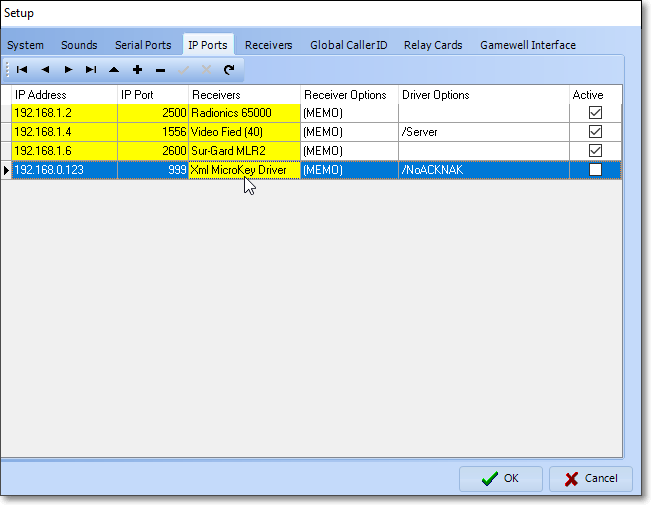❑The Xml MicroKey Driver has an /NoACKNAK "Driver Option"
•This /NoACKNAK option is entered in the Driver Option column located on the IP Port tab in the SPA Setup Form

SPA Setup Form - IP Ports tab - Xml MicroKey Driver entry
✓The /NoACKNAK Driver Option inhibits (i.e., turns off) the ACK and NAK packages SPA sends back to the XML Sending Device (e.g., Communicator, Control Panel) connected to the XML IP COM port address/port or the serial port.
▪It does not have anything to do with Supervision on the SPA side of things.
▪ACK/NAK packages are for the benefit of the XML Sending Device, not SPA.
✓Why is this feature available?
▪Some Central Stations still use older/more basic XML Sending Devices that cannot deal with (e.g., understand, use) ACK/NAK package handshakes.
▪More sophisticated XML Sending Devices can resend a NAK'd package or alert an Operator if the NAK was due to invalid data.
✓Because of this, it is important to Check the Supervise Receivers box found on the System tab in the SPA Setup Form when you implement this /NoACKNAK option.
▪Turning on supervision in SPA would result in the A101 - Receiver Failed to Respond to Communications check, and A102 - Receiver Restored signals being created as appropriate by SPA if the XML Sending Device is not sending at least 1 package every 30 seconds.
▪An Empty (SignalCount=0) alarm package is fine for supervision purposes and will reset SPA's supervision timer for the Xml MicroKey Driver.
❑There is a Company Settings option named PulseUnattendedRelay which your System Administrator may be add , if needed, and should initially be set to True ("T").
•If needed, the PulseUnattendedRelay Company Settings option must be a manually entered into dba.CompanySettings.
•When PulseUnattendedRelay is created and set to True ("T"), SPA will pulse the designated Unattended Alarms relay (see User Options > Central Station Options > Alerts tab > Unattended Alarms) for 1 second when one or more new (30 seconds of age or less) A126 - Unattended Alarms Activation records are detected in the Alarm History table.
✓There is a 60 second anti-race condition timer that limits the maximum Unattended Alarms Activation relay pulse rate to once per minute.
✓This implies that there would have to be new A126 - Unattended Alarms Activation - records in Alarm History after the initial 1 minute period.
•Setting the PulseUnattendedRelay option to False ("F") causes the Unattended Alarms (see User Options > Central Station Options > Alerts tab > Unattended Alarms) relay to remain on until all the A126 - Unattended Alarms Activation alarm records age to 30 seconds or older, which is the original behavior.
✓Therefore, whether the PulseUnattendedRelay option is set to False ("F") or it's Undefined, SPA assumes you want to use the old relay behavior which is: the Unattended Alarms relay will stay energized until until all Unattended Alarms have been serviced.